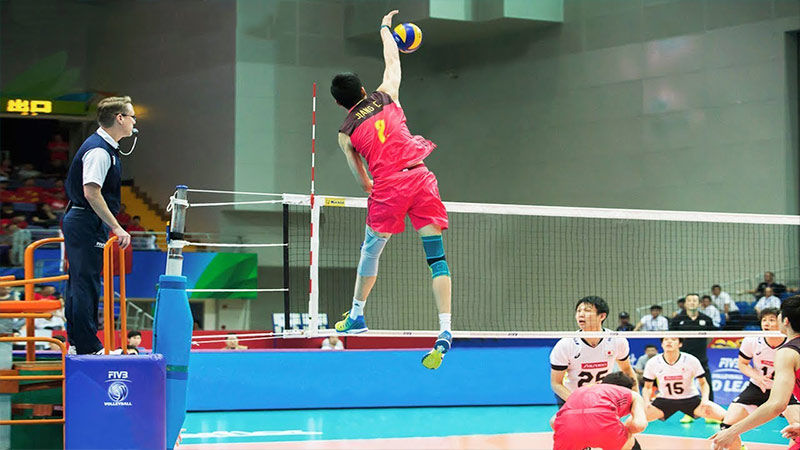In the exhilarating world of volleyball, the approach jump is a skill that can elevate your game to new heights – quite literally! But what is a good approach to jumping in volleyball, and why is it so crucial?
In this blog post, we will delve into the intricacies of this fundamental technique and unveil the secrets to achieving a remarkable approach jump.
A good approach jump isn’t just about reaching higher; it’s about timing, technique, and the perfect blend of power and precision.
Whether you’re a beginner aiming to make your first spike or a seasoned pro looking to enhance your skills, understanding the nuances of the approach jump is paramount.
We’ll explore the factors that contribute to a stellar approach jump, how to measure it, and tips for improvement.
So, prepare to dig deep into the world of volleyball and discover what it takes to reach your maximum potential with an impeccable approach jump! Stay focused.
What Is a Good Approach Jump in Volleyball?
A good approach to jumping in volleyball is essential for effective spiking and blocking. Here are the key points to consider:
Timing and Coordination
The approach jump begins with a well-timed and coordinated sequence of steps.
Start a few feet behind the ball’s anticipated trajectory, and time your approach so you reach the ball at its peak. This ensures maximum height and power.
Footwork
Use a four-step approach for hitting: a left-right-left-right sequence for right-handed players (right-left-right-left for left-handed players).
Maintain a steady, rhythmic stride that allows for balance and quick adjustments to the ball’s location.
Plant Foot and Takeoff
The last two steps of your approach are crucial. The penultimate step (second to last) should be your plant foot, which is usually your non-dominant foot. It’s where you gather power and momentum.
The final step is your takeoff, where you push off the ground with your plant foot, generating vertical force.
Arms and Follow-Through
As you jump, swing your dominant arm back, and then forward to generate power and control. Your non-dominant arm should be raised to help with balance and positioning.
After making contact with the ball, follow through with your arm and upper body in the direction you want the ball to go.
By mastering these components of a good approach jump, you’ll enhance your ability to deliver powerful and accurate spikes in volleyball.
The Basics of a Volleyball Approach Vertical Jump
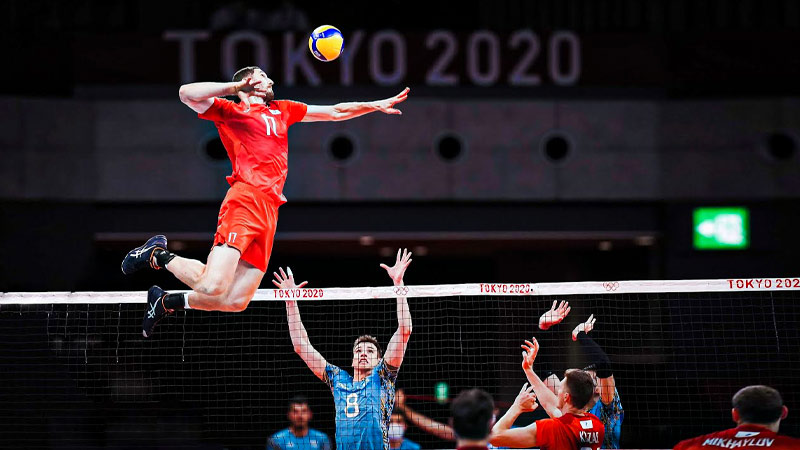
The volleyball approach vertical jump is a fundamental skill for both attacking (spiking) and blocking in volleyball.
Here are the basic components of a volleyball approach vertical jump:
Footwork
The approach for a vertical jump typically involves a three or four-step sequence, depending on the player’s preference and position.
The key is to approach the ball with a quick, coordinated, and rhythmic sequence of steps. A four-step approach is common for hitting, while blocking often uses a three-step approach.
Timing
Timing is crucial in volleyball. The approach should be timed so that you reach the peak of your jump just as the ball is at its highest point.
This ensures that you can make contact with the ball at the most advantageous position for power and accuracy.
Plant Foot
The penultimate step (second to last step) is critical for generating upward momentum.
This step is typically taken with the non-dominant foot and acts as a pivot point for the takeoff. The plant foot should be positioned in the direction you want to jump.
Takeoff
The final step in the approach is the takeoff. Push off the ground with your plant foot while swinging your arms upward for momentum. Explode off the ground with power and precision, driving your body vertically.
Arm Swing
The arm swing is crucial for generating power and accuracy in hitting. As you jump, your dominant arm should be pulled back, ready to attack the ball.
It should then swing forward forcefully to make contact with the ball at the highest point of your jump. Your non-dominant arm helps with balance and positioning.
Follow-Through
After making contact with the ball, follow through with your arm and upper body in the direction you want the ball to go. A well-executed follow-through ensures better control and placement of your shots.
Blocking Considerations
For blocking, the approach vertical jump is used to reach the net and block an opponent’s attack.
Timing and positioning at the net are critical, and you should aim to reach over the net with your hands and fingers, while also being ready to redirect or counter the ball.
By mastering these basic components of the volleyball approach vertical jump, you can enhance your performance as both an attacker and a blocker in the game.
Volleyball Approach Jump Measurement
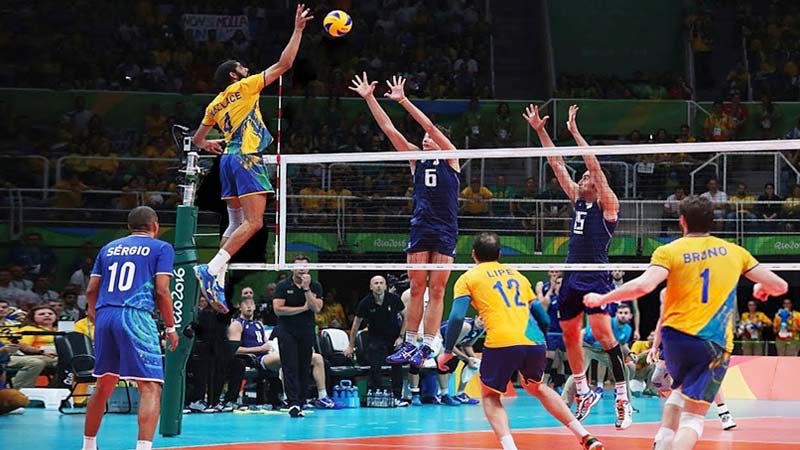
Measuring a volleyball approach jump is essential for assessing a player’s vertical leap and can help track progress and identify areas for improvement.
Here are the key points in measuring a volleyball approach jump:
Vertical Reach
One of the primary measurements for an approach jump is the player’s vertical reach. This involves determining how high a player can reach above the net when jumping at their maximum effort.
To measure this, a standard measuring device like a Vertec or a Vert Jump mat can be used. The player jumps and touches the highest point they can, and the measurement is recorded.
Jump Height
This measurement focuses on how high a player can jump from the ground during their approach.
It’s typically recorded as the difference between the player’s standing reach and their reach when jumping. This jump height is important for spiking, blocking, and general athleticism.
Contact Height
For hitting and blocking, it’s crucial to measure the contact height. This is the point at which the player makes contact with the ball at the peak of their jump.
To measure this, you’ll need to record the height of the net and calculate how much above the net the player contacts the ball. It’s an essential metric for offensive and defensive play.
Speed and Timing
While not directly a measurement of height, the speed and timing of the approach jump are crucial factors.
Players should be assessed for the speed and coordination of their approach steps and the timing of their takeoff. Efficient speed and precise timing are key for reaching maximum height during the jump.
Repetition and Progression
Measuring the approach jump should be an ongoing process. Players can track their progress over time, aiming to increase their jump height, contact height, and overall performance.
Regular measurements can help identify areas for improvement and gauge the effectiveness of training and conditioning programs.
Accurate measurement of a player’s approach jump is valuable for coaches, trainers, and athletes themselves as it provides insight into a player’s vertical capabilities and helps set performance goals for volleyball players.
The Four Phases of a Perfect Approach Jump
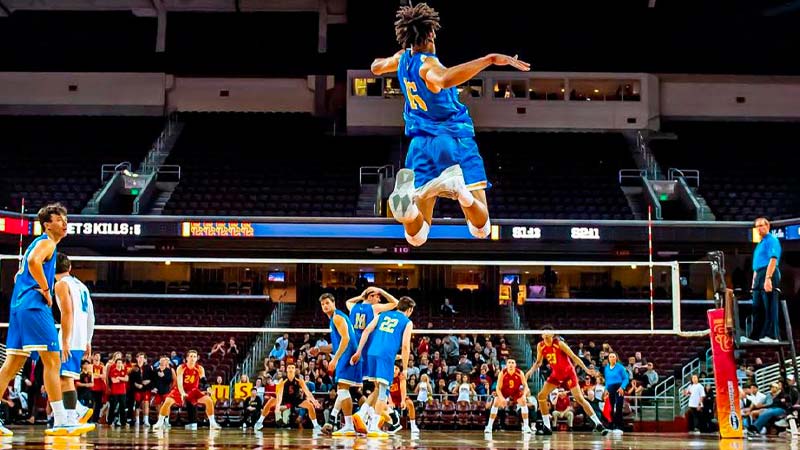
The approach jump in volleyball can be broken down into four distinct phases to ensure a perfect execution:
Starting Position
- Begin in a ready position with your feet shoulder-width apart.
- Stay low with bent knees and a slight forward lean to facilitate quick movement.
- Keep your weight evenly distributed between both feet, ready to react to the ball.
Approach
- Start with a coordinated and rhythmic sequence of steps, typically involving three or four steps, depending on your preference and position.
- Maintain a fluid and continuous movement, ensuring that the steps are quick and balanced.
- Position your penultimate step (second to last) as the plant foot, usually with your non-dominant foot.
- Keep your eyes on the ball and anticipate its trajectory.
Takeoff
- As you approach the ball, push off the ground with your plant foot.
- Swing your arms upward and backward to generate upward momentum.
- Explode off the ground with power, aiming to reach your maximum jump height.
- Keep your body upright and your core engaged to maintain balance.
Contact and Follow-Through
- At the peak of your jump, make contact with the ball using your dominant arm, aiming for a well-timed and controlled spike.
- Extend your hitting arm fully and snap your wrist to create power and accuracy.
- Your non-dominant arm should assist with balance and positioning.
- After making contact, follow through with your hitting arm and upper body in the direction you want the ball to go.
These four phases, when executed with precision and fluidity, contribute to a perfect approach jump in volleyball.
Factors That Affect Average Approach Jump Volleyball
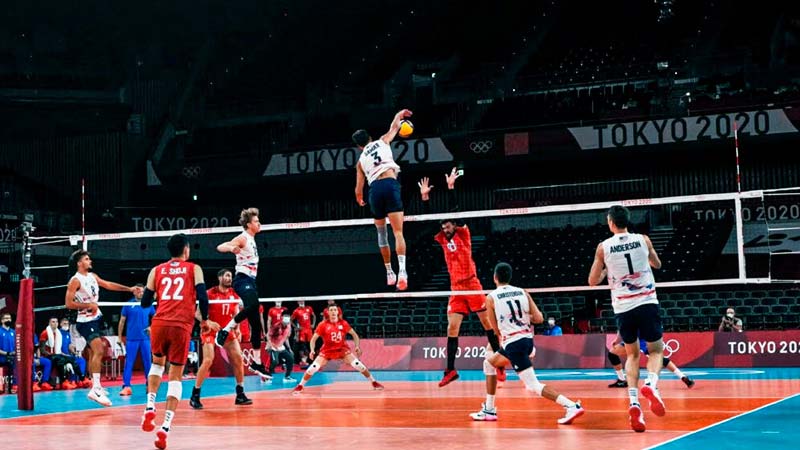
Several factors can affect the average approach jump in volleyball.
These factors can vary among individual players and may influence their ability to reach their maximum jumping potential. Here are some key factors:
Strength and Conditioning
A player’s physical strength and overall conditioning significantly affect their approach to jump.
Strength in the legs, core, and upper body is essential for generating the power needed to jump higher. Proper conditioning and training can lead to improved jump height.
Technique and Timing
The proper execution of the approach jump technique, including the timing of the steps, arm swing, and takeoff, plays a critical role in achieving maximum jump height.
Flawed technique or mistimed steps can limit a player’s vertical reach.
Explosiveness and Speed
Explosiveness and speed are essential components of a successful approach jump.
Players who can generate rapid acceleration during their approach steps and explode off the ground with speed are more likely to reach greater heights during their jumps.
Biomechanical Factors
Individual biomechanical factors, such as a player’s natural height, limb length, and body composition, can affect their average approach jump.
Taller players, for instance, may have a higher reach, while limb length can impact the effectiveness of the arm swing.
Mental Preparation
Mental factors, including focus, confidence, and the ability to handle pressure, can influence a player’s approach to jump.
Nervousness or lack of confidence can negatively impact performance, while a strong mental game can help players reach their potential.
Improving the average approach jump in volleyball involves a combination of strength training, technique refinement, speed and agility development, and mental conditioning.
What Is a Good Approach Touch in Volleyball?
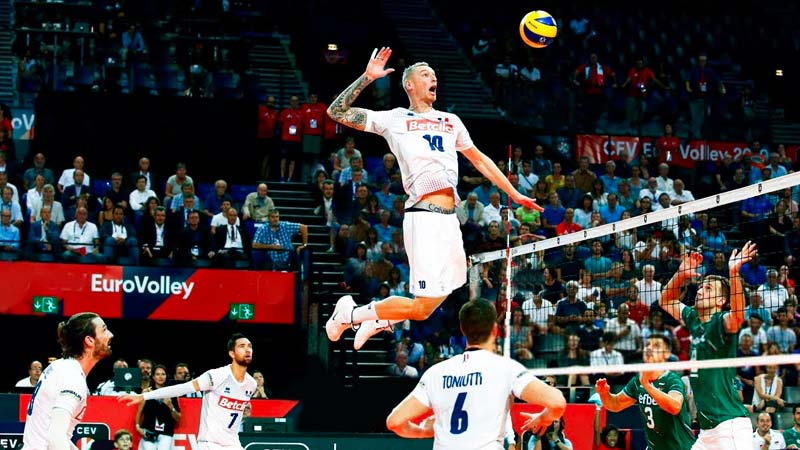
A good approach touch in volleyball refers to the maximum height a player can reach while executing an approach jump.
It’s a critical measurement for hitting and blocking. Here are some key points regarding a good approach touch:
Individual Variation
A good approach touch is relative to the individual player’s abilities and position.
The average approach touch for a male professional volleyball player can range from 11.5 to 12.5 feet (3.5 to 3.8 meters) above the ground.
For female professional players, it’s typically in the range of 10.5 to 11.5 feet (3.2 to 3.5 meters).
However, players in different positions (e.g., outside hitters, and middle blockers) may have varying height goals.
Importance of Timing
Achieving a good approach touch is not solely about raw jumping height but also about timing.
A well-timed approach allows a player to reach their maximum jump height at the ideal moment to make contact with the ball.
This timing can make a significant difference in the effectiveness of a spike or block.
Training and Conditioning
Players can improve their approach touch through targeted strength and conditioning exercises, focusing on leg and core strength.
Plyometric training and agility work can also enhance explosiveness, which contributes to a higher approach touch.
Biomechanics and Technique
Proper execution of the approach jump, including the sequence of steps, the takeoff, and the arm swing, can maximize the approach touch.
Working on techniques to ensure efficiency and balance is essential.
Monitoring and Progression
Coaches and players should regularly monitor and track approach touch as a metric of improvement.
By setting specific goals and tracking progress, players can work towards achieving a good approach touch for their position.
A good approach to touch varies from player to player and depends on position and individual capabilities.
FAQs
What is a good approach to jump in volleyball?
A good approach jump in volleyball refers to a player’s ability to reach their maximum height during a spike or block.
It’s about timing, technique, and explosive power, allowing players to make effective plays at the net.
How can I improve my approach jump?
To improve your approach to jumping, focus on strength training, plyometrics, and agility exercises.
Work on your approach technique and timing. Regular practice and conditioning can help you jump higher and more efficiently.
Is there an ideal approach to jump height for all players?
No, the ideal approach jump height varies among players and positions. Outside hitters may aim for higher jumps than setters, for example.
It’s crucial to set individual goals based on position and physical abilities.
Can mental preparation affect the approach jump?
Yes, mental factors like focus and confidence play a significant role in the approach jump.
Nervousness or lack of confidence can affect performance, while a strong mental game can help maximize your jumping potential.
How do I measure my approach jump height?
Approach jump height is typically measured using devices like Vertec or Vert Jump mats. Jump and touch the highest point you can reach.
The difference between your standing reach and your jump reach is your approach jump height, which can be tracked to monitor progress.
Wrapping Up
In the world of volleyball, the approach jump is the key to success at the net. A good approach jump is a combination of strength, timing, and technique.
Whether you’re striving for that perfect spike or a formidable block, mastering the approach jump is a journey worth embarking on.
By understanding the nuances, focusing on training, and continuously working to improve, you can elevate your game and make a significant impact on the court. So, keep practicing, keep refining, and keep reaching new heights.
Your approach jump is not just a skill; it’s a testament to your dedication and passion for the sport, and it will undoubtedly set you on a path to volleyball excellence. Thank you so much.

